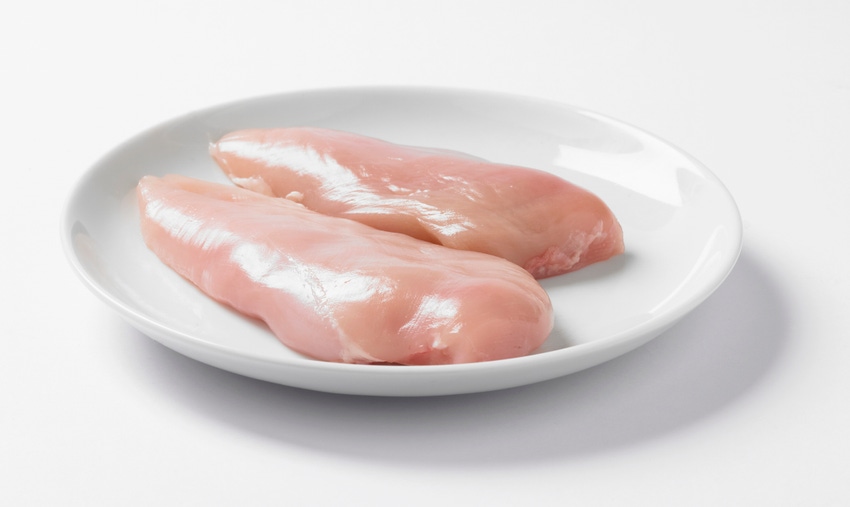Research documents important metabolic changes in birds with breast muscle abnormalities.

The U.S. Poultry & Egg Assn. (USPOULTRY) and the USPOULTRY Foundation announced the completion of a funded research project at North Carolina State University in which researchers found that amino acid supplementation does not affect white striping and wooden breast in broiler chickens.
In the research, Dr. Kimberly Livingston and colleagues at North Carolina State determined the effects of supplemental glutamine and arginine on the incidence and severity of white striping and wooden breast in broiler chickens. USPOULTRY said the research clearly showed that supplementation of these amino acids did not reduce the incidence or severity of either condition. The research also documented several important metabolic changes that occur in birds with these muscle conditions.
Livingston explained that breast muscle abnormalities (myopathies) are a growing concern, with broiler plants worldwide seeing a significant increased frequency of white striping and wooden breast.
The working hypothesis for this research was that dietary L-glutamine and arginine supplementation would decrease the incidence of muscle myopathies and reduce the local damaging immune response in breast tissue, thus creating higher yields of broiler meat, Livingston reported.
To test this hypothesis and understand the mechanisms, Livingston's team had the following objectives:
1. Investigate the effects of dietary L-glutamine and arginine supplementation on the incidence of muscle myopathies commonly known as white striping and wooden breast.
2. Evaluate growth and muscle gain of broiler chickens fed dietary L-glutamine and arginine.
3. Evaluate metabolic changes that occur with white striping and wooden breast.
4. Determine the local breast tissue immune cell population and systemic spleen immune cell population.
5. Determine how RNA expression is altered with the progression of the wooden breast myopathies, and see if supplemental glutamine and arginine alleviate the disease.
The addition of supplementary dietary L-glutamine and arginine did not reduce the incidence of wooden breast or white striping, Livingston said. In fact, she said the addition of L-glutamine increased the incidence of white striping and increased the fat concentration in breast tissue.
Birds that were fed supplemental L-glutamine and arginine in a diet providing a calcium-to-phosphorous ratio of 1.8:1.0 gained more weight and had better feed conversion ratios, but this response was not observed at a 2.2:1.0 calcium:phosphorus ratio, Livingston reported.
Broilers fed L-glutamine had blood chemistry values exhibiting increased packed cell volume (PCV) and total carbon dioxide and a reduction in partial pressure of oxygen and oxygen saturation, the researcher said. Broilers fed supplemental arginine exhibited increased PCV, partial pressure of carbon dioxide, total carbon dioxide and bicarbonate (HCO3) and a reduction in partial pressure of oxygen and oxygen saturation.
As bodyweight increased, wooden breast scores increased, with a similar increasing trend occurring in white striping scores, Livingston said, noting that as wooden breast severity increased from one to four, there was an obvious trend of reduced blood saturated oxygen and partial pressure of oxygen and increased PCV, partial pressure of carbon dioxide, total carbon dioxide and HCO3.
Moreover, she said as white striping severity increased from one to four, there was a significant increase in total carbon dioxide, HCO3 and PCV, while a reduction in blood saturated oxygen and partial pressure of oxygen were also observed.
Livingston reported that these data indicate a condition of relative hypoxia in affected birds.
Broilers given supplemental L-glutamine had lower CD4+ T-cells (specialized immune cells) in the muscle tissue, which returned to normal levels when arginine was also supplemented, Livingston noted. No differences in immune cells were observed among different wooden breast scores.
She said dietary treatments did not alter the RNA sequencing data. However, the greatest difference in RNA expression was due to wooden breast score. The changes in wooden breast severity resulted in changes in the expression of more than 1,450 genes.
According to Livingston, this research shows the physiological differences that occur in birds that present with wooden breast and white striping. In addition, mRNA expression data give an indication of the changes in cellular signaling mechanisms that are leading to the progression of the disease, she added.
It is clear that added supplemental amino acids glutamine and arginine do not ameliorate the myopathies, Livingston concluded.
Poultry house ammonia
In other research at North Carolina State University funded by USPOULTRY and the USPOULTRY Foundation, researchers evaluated filtration systems with the goal of reducing ammonia in poultry houses.
In this study, Dr. Sanjay Shah and colleagues at North Carolina State developed and tested an ammonia filtration system for use inside a poultry house. Shah said a system to remove ammonia from the poultry house environment could provide improvements in the health and well-being of chickens and turkeys.
The project made significant progress toward the goal of producing a practical ammonia filtration system and will provide the basis for future innovations, the researchers concluded.
A research summary for this and other research projects can be found on the USPOULTRY website at www.uspoultry.org.
About the Author(s)
You May Also Like

.png?width=300&auto=webp&quality=80&disable=upscale)

